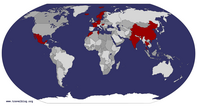Thailand 2003
September 1st 2003 -» September 15th 2003
Stockholm 2004
January 23rd 2004 -» January 26th 2004
Mexico 2004
April 6th 2004 -» April 21st 2004
Southern Tunisia 2004
September 18th 2004 -» September 25th 2004
Budapest 2005
March 21st 2005 -» March 25th 2005
Copenhagen 2006
February 11th 2006 -» February 15th 2006
Lapland, Lofoten islands & The North Cape 2006
June 15th 2006 -» June 27th 2006
Beijing 2007
February 17th 2007 -» February 24th 2007
Mosselle valley 2007
June 16th 2007 -» June 22nd 2007
Marrakesh 2007
December 11th 2007 -» December 14th 2007
Southern Iceland 2010
April 1st 2010 -» April 5th 2010
Lille 2011
December 10th 2011 -» December 11th 2011
L'Aisne 2012
June 1st 2012 -» June 8th 2012
Cologne 2012
December 13th 2012 -» December 15th 2012
Drenthe 2013
August 14th 2013 -» August 20th 2013
India's Golden Triangle 2014
February 15th 2014 -» February 22nd 2014





